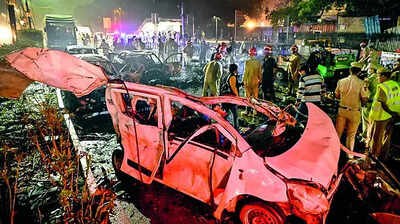NEW DELHI: The Capital was shaken on Monday evening after a powerful explosion near the Red Fort Metro Station killed at least eight people and injured 24 others. The blast gutted several vehicles and sent panic through the busy area crowded with commuters and tourists. The injured were taken to LNJP Hospital, a short distance from the site.For a city that has lived through some of the country’s most violent terror strikes, the sound of another explosion felt like a grim reminder of earlier tragedies. Delhi’s markets, monuments and public spaces have repeatedly been thrust to the forefront of such violence, each incident leaving its mark.In 1996, a bomb tore through Lajpat Nagar market, killing 13 people and injuring many more, casting a pall over one of the capital’s busiest commercial hubs. The following year, a series of blasts hit Sadar Bazaar, Karol Bagh, Rani Bagh, Chandni Chowk and even a moving bus in Punjabi Bagh, striking at the everyday spaces where life unfolded.The Red Fort has itself been a symbolic target. In December 2000, two people were killed after a terror group opened fire inside the fort complex. The Parliament attack the next year once again placed Delhi at the center of national shock, claiming the lives of security personnel and staff. In 2005, coordinated explosions ahead of Diwali ripped through Paharganj, Sarojini Nagar and a DTC bus in Govindpuri, killing more than 67 people and injuring over 200. Three years later, in 2008, a series of blasts in Connaught Place, Karol Bagh and Greater Kailash claimed more lives and deepened public anxiety.The last major strike before Monday’s explosion was in 2011, when a briefcase bomb outside the Delhi High Court killed 15 and injured 79.With the latest blast near the Red Fort, the fragile sense of calm the city had rebuilt has been disturbed once more, reviving memories of the years when terror sought to test Delhi’s resilience.




